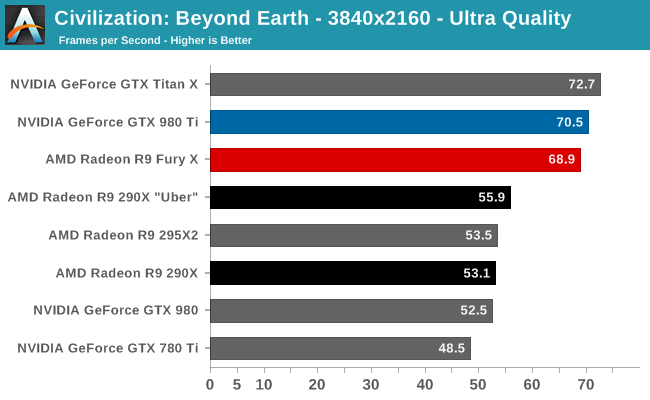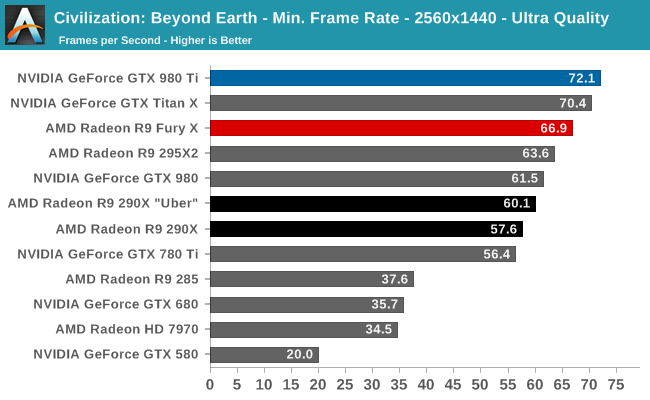The AMD Radeon R9 Fury X Review: Aiming For the Top
by Ryan Smith on July 2, 2015 11:15 AM ESTCivilization: Beyond Earth
Shifting gears from action to strategy, we have Civilization: Beyond Earth, the latest in the Civilization series of strategy games. Civilization is not quite as GPU-demanding as some of our action games, but at Ultra quality it can still pose a challenge for even high-end video cards. Meanwhile as the first Mantle-enabled strategy title Civilization gives us an interesting look into low-level API performance on larger scale games, along with a look at developer Firaxis’s interesting use of split frame rendering with Mantle to reduce latency rather than improving framerates.


Unlike Battlefield 4 where we needed to switch back to DirectX for performance reasons on the R9 Fury X, AMD’s latest card still holds up rather well on Mantle here, probably due to the fact that Civilization is a newer game. Though not drawn in this chart, what we find is that AMD loses a frame or two per second for running Mantle, but in return they see far, far better minimums (more on that later).
Overall then the R9 Fury X looks pretty good at 4K. Even at Ultra quality it can deliver a better than 60fps average and is within 2% of the GTX 980 Ti. On the other hand AMD struggles a bit more at 1440p, where the absolute framerate is still rather high, but relative to the GTX 980 Ti it’s now an 11% performance gap. This being a Mantle game, the fact that AMD does fall behind is a bit surprising, as at a high level they should be enjoying the CPU benefits of the low-level API. We’ll revisit 1440p performance a bit later on, but this is going to be a recurring quirk for AMD, and a detriment for 1440p 144Hz monitor owners.


The bigger advantage of Mantle is really the minimum framerates, and here the R9 Fury X soars. At 4K the R9 Fury X delivers a minimum framerate of 50.5fps, some 20% better than the GTX 980 Ti. Both cards do well enough here, but it goes without saying that this is a very distinct difference, and one that is well in AMD’s favor. The only downside for AMD here is that they can’t keep this advantage at 1440p, where they go back to trailing the GTX 980 Ti in minimum framerates by 7%.
On that note I do have one concern here with AMD’s support plans for Mantle. Mainly I’m worried that as well as the R9 Fury X does here, there’s a risk Mantle may stop working in the future. The GCN 1.2 based R9 285 can’t use the Mantle path at all (it crashes), and the R9 Fury X is not all that different in architecture.










458 Comments
View All Comments
Navvie - Thursday, July 2, 2015 - link
"Which is not say I’m looking" (paragraph 5, first line).Missing a "to" I think.
watzupken - Thursday, July 2, 2015 - link
Brilliant review. Well worth the wait. Thanks Ryan.Taracta - Thursday, July 2, 2015 - link
ROPs, ROPs, ROPs! Hows can they ~ double everything else and keep the same amount of ROPs and expect to win?Thatguy97 - Thursday, July 2, 2015 - link
maybe something to do with cost or yieldtipoo - Thursday, July 2, 2015 - link
They literally hit the size limits interposers can scale up to with this chip - so they can't make it any bigger to pack more transistors for more ROPs, until a die shrink. So they decided on a tradeoff, favouring other things than ROPs.Kevin G - Thursday, July 2, 2015 - link
They had a monster shader count and likely would be fine if they went to 3840 max to make room for more ROPs. 96 or 128 ROPs would have been impressive and really made this chip push lots of pixels. With HBM and the new delta color compression algorithm, there should be enough bandwidth to support these additional ROPs without bottle necking them.AMD also scaled the number of TMUs with the shaders but it likely wouldn't have hurt to have increased them by 50% too. Alternatively AMD could have redesigned the TMUs to have better 16 bit per channel texture support. Either of these changes would have put the texel throughput well beyond the GM200's theoretical throughput. I have a feeling that this is one of the bottlenecks that helps the GM200 pull ahead of Fiji.
tipoo - Friday, July 3, 2015 - link
Not saying it was the best tradeoff - just explaining. They quite literally could not go bigger in this case.testbug00 - Sunday, July 5, 2015 - link
the performances scaling as resolution increase is better than Nvidia, implying the ROPs aren't the bottleneck...chizow - Sunday, July 5, 2015 - link
No, that implies the shaders are the bottleneck at higher resolutions while ROP/fillrate/geometry remained constant. While Nvidia's bottleneck at lower resolutions isn't shader bound but their higher ROP/fillrate allows them to realize this benefit in actual FPS, AMD's ROPs are saturated and simply can't produce more frames.Ryan Smith - Thursday, July 2, 2015 - link
Right now there's not a lot of evidence for R9 Fury X being ROP limited. The performance we're seeing does not have any tell-tale signs of being ROP-bound, only hints here and there that may be the ROPs, or could just as well be the front-end.While Hawaii was due for the update, I'm not so sure we need to jump up in ROPs again so soon.